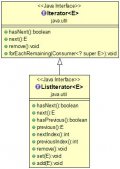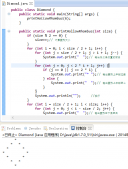前言
我们知道,ioc是spring的核心。它来负责控制对象的生命周期和对象间的关系。
举个例子,我们如何来找对象的呢?常见的情况是,在路上要到处去看哪个mm既漂亮身材又好,符合我们的口味。就打听她们的电话号码,制造关联想办法认识她们,然后...这里省略n步,最后谈恋爱结婚。
ioc在这里就像婚介所,里面有很多适婚男女的资料,如果你有需求,直接告诉它你需要个什么样的女朋友就好了。它会给我们提供一个mm,直接谈恋爱结婚,完美!
下面就来看spring是如何生成并管理这些对象的呢?
1、方法入口
org.springframework.beans.factory.support.defaultlistablebeanfactory.preinstantiatesingletons()方法是今天的主角,一切从它开始。
|
1
2
3
4
5
6
7
8
9
10
11
|
public void preinstantiatesingletons() throws beansexception { //beandefinitionnames就是上一节初始化完成后的所有beandefinition的beanname list<string> beannames = new arraylist<string>(this.beandefinitionnames); for (string beanname : beannames) { rootbeandefinition bd = getmergedlocalbeandefinition(beanname); if (!bd.isabstract() && bd.issingleton() && !bd.islazyinit()) { //getbean是主力中的主力,负责实例化bean和ioc依赖注入 getbean(beanname); } } } |
2、bean的实例化
在入口方法getbean中,首先调用了docreatebean方法。第一步就是通过反射实例化一个bean。
|
1
2
3
4
5
6
7
8
9
10
11
|
protected object docreatebean(final string beanname, final rootbeandefinition mbd, final object[] args) { // instantiate the bean. beanwrapper instancewrapper = null; if (mbd.issingleton()) { instancewrapper = this.factorybeaninstancecache.remove(beanname); } if (instancewrapper == null) { //createbeaninstance就是实例化bean的过程,无非就是一些判断加反射,最后调用ctor.newinstance(args); instancewrapper = createbeaninstance(beanname, mbd, args); }} |
3、annotation的支持
在bean实例化完成之后,会进入一段后置处理器的代码。从代码上看,过滤实现了mergedbeandefinitionpostprocessor接口的类,调用其postprocessmergedbeandefinition()方法。都是谁实现了mergedbeandefinitionpostprocessor接口呢?我们重点看三个
- autowiredannotationbeanpostprocessor
- commonannotationbeanpostprocessor
- requiredannotationbeanpostprocessor
记不记得在spring源码分析(一)spring的初始化和xml这一章节中,我们说spring对annotation-config标签的支持,注册了一些特殊的bean,正好就包含上面这三个。下面来看它们偷偷做了什么呢?
从方法名字来看,它们做了相同一件事,加载注解元数据。方法内部又做了相同的两件事
|
1
2
|
reflectionutils.dowithlocalfields(targetclass, new reflectionutils.fieldcallback() reflectionutils.dowithlocalmethods(targetclass, new reflectionutils.methodcallback() |
看方法的参数,targetclass就是bean的class对象。接下来就可以获取它的字段和方法,判断是否包含了相应的注解,最后转成injectionmetadata对象,下面以一段伪代码展示处理过程。
|
1
2
3
4
5
6
7
8
9
10
11
12
13
14
15
16
17
18
19
|
public static void main(string[] args) throws classnotfoundexception { class<?> clazz = class.forname("com.viewscenes.netsupervisor.entity.user"); field[] fields = clazz.getfields(); method[] methods = clazz.getmethods(); for (int i = 0; i < fields.length; i++) { field field = fields[i]; if (field.isannotationpresent(autowired.class)) { //转换成autowiredfieldelement对象,加入容器 } } for (int i = 0; i < methods.length; i++) { method method = methods[i]; if (method.isannotationpresent(autowired.class)) { //转换成autowiredmethodelement对象,加入容器 } } return new injectionmetadata(clazz, elements);} |
injectionmetadata对象有两个重要的属性:targetclass ,injectedelements,在注解式的依赖注入的时候重点就靠它们。
|
1
2
3
4
5
6
7
8
9
10
11
12
13
|
public injectionmetadata(class<?> targetclass, collection<injectedelement> elements) { //targetclass是bean的class对象 this.targetclass = targetclass; //injectedelements是一个injectedelement对象的集合 this.injectedelements = elements;}//member是成员本身,字段或者方法//pd是jdk中的内省机制对象,后面的注入属性值要用到protected injectedelement(member member, propertydescriptor pd) { this.member = member; this.isfield = (member instanceof field); this.pd = pd;} |
说了这么多,最后再看下源码里面是什么样的,以autowired 为例。
|
1
2
3
4
5
6
7
8
9
10
11
12
13
14
15
16
17
18
19
20
21
22
23
24
25
26
27
28
29
30
31
32
33
34
35
36
37
38
39
40
41
42
43
|
reflectionutils.dowithlocalfields(targetclass, new reflectionutils.fieldcallback() { @override public void dowith(field field) throws illegalargumentexception, illegalaccessexception { annotationattributes ann = findautowiredannotation(field); if (ann != null) { if (modifier.isstatic(field.getmodifiers())) { if (logger.iswarnenabled()) { logger.warn("autowired annotation is not supported on static fields: " + field); } return; } boolean required = determinerequiredstatus(ann); currelements.add(new autowiredfieldelement(field, required)); } }});reflectionutils.dowithlocalmethods(targetclass, new reflectionutils.methodcallback() { @override public void dowith(method method) throws illegalargumentexception, illegalaccessexception { method bridgedmethod = bridgemethodresolver.findbridgedmethod(method); if (!bridgemethodresolver.isvisibilitybridgemethodpair(method, bridgedmethod)) { return; } annotationattributes ann = findautowiredannotation(bridgedmethod); if (ann != null && method.equals(classutils.getmostspecificmethod(method, clazz))) { if (modifier.isstatic(method.getmodifiers())) { if (logger.iswarnenabled()) { logger.warn("autowired annotation is not supported on static methods: " + method); } return; } if (method.getparametertypes().length == 0) { if (logger.iswarnenabled()) { logger.warn("autowired annotation should be used on methods with parameters: " + method); } } boolean required = determinerequiredstatus(ann); propertydescriptor pd = beanutils.findpropertyformethod(bridgedmethod, clazz); currelements.add(new autowiredmethodelement(method, required, pd)); } }}); |
4、依赖注入
前面完成了在docreatebean()方法bean的实例化,接下来就是依赖注入。
bean的依赖注入有两种方式,一种是配置文件,一种是注解式。
4.1、 注解式的注入过程
在上面第3小节,spring已经过滤了bean实例上包含@autowired、@resource等注解的field和method,并返回了包含class对象、内省对象、成员的injectionmetadata对象。还是以@autowired为例,这次调用到autowiredannotationbeanpostprocessor.postprocesspropertyvalues()。
首先拿到injectionmetadata对象,再判断里面的injectedelement集合是否为空,也就是说判断在bean的字段和方法上是否包含@autowired。然后调用injectedelement.inject()。injectedelement有两个子类autowiredfieldelement、autowiredmethodelement,很显然一个是处理field,一个是处理method。
4.1.1 autowiredfieldelement
如果autowired注解在字段上,它的配置是这样。
|
1
2
3
4
|
public class user { @autowired role role;} |
|
1
2
3
4
5
6
7
8
9
10
11
12
13
14
15
16
17
18
19
20
21
22
23
|
protected void inject(object bean, string beanname, propertyvalues pvs) throws throwable { //以user类中的@autowired role role为例,这里的field就是 //public com.viewscenes.netsupervisor.entity.role com.viewscenes.netsupervisor.entity.user.role field field = (field) this.member; object value; dependencydescriptor desc = new dependencydescriptor(field, this.required); desc.setcontainingclass(bean.getclass()); set<string> autowiredbeannames = new linkedhashset<string>(1); typeconverter typeconverter = beanfactory.gettypeconverter(); try { //这里的beanname因为bean,所以会重新进入populatebean方法,先完成role对象的注入 //value == com.viewscenes.netsupervisor.entity.role@7228c85c value = beanfactory.resolvedependency(desc, beanname, autowiredbeannames, typeconverter); } catch (beansexception ex) { throw new unsatisfieddependencyexception(null, beanname, new injectionpoint(field), ex); } if (value != null) { //设置可访问,直接赋值 reflectionutils.makeaccessible(field); field.set(bean, value); }} |
4.1.2 autowiredfieldelement
如果autowired注解在方法上,就得这样写。
|
1
2
3
4
|
public class user { @autowired public void setrole(role role) {}} |
它的inject方法和上面类似,不过最后是method.invoke。感兴趣的小伙伴可以去翻翻源码。
|
1
2
|
reflectionutils.makeaccessible(method);method.invoke(bean, arguments); |
4.2、配置文件的注入过程
先来看一个配置文件,我们在user类中注入了id,name,age和role的实例。
|
1
2
3
4
5
6
7
8
9
10
|
<bean id="user" class="com.viewscenes.netsupervisor.entity.user"> <property name="id" value="1001"></property> <property name="name" value="网机动车"></property> <property name="age" value="24"></property> <property name="role" ref="role"></property></bean><bean id="role" class="com.viewscenes.netsupervisor.entity.role"> <property name="id" value="1002"></property> <property name="name" value="中心管理员"></property></bean> |
在spring源码分析(一)spring的初始化和xml这一章节的4.2 小节,bean标签的解析,我们看到在反射得到bean的class对象后,会设置它的property属性,也就是调用了parsepropertyelements()方法。在beandefinition对象里有个mutablepropertyvalues属性。
|
1
2
3
4
5
6
7
8
9
|
mutablepropertyvalues: //propertyvaluelist就是有几个property 节点 list<propertyvalue> propertyvaluelist: propertyvalue: name //对应配置文件中的name ==id value //对应配置文件中的value ==1001 propertyvalue: name //对应配置文件中的name ==name value //对应配置文件中的value ==网机动车 |
上图就是beandefinition对象里面mutablepropertyvalues属性的结构。既然已经拿到了property的名称和值,注入就比较简单了。从内省对象propertydescriptor中拿到writemethod对象,设置可访问,invoke即可。propertydescriptor有两个对象readmethodref、writemethodref其实对应的就是get set方法。
|
1
2
3
4
5
6
7
8
|
public void setvalue(final object object, object valuetoapply) throws exception { //pd 是内省对象propertydescriptor final method writemethod = this.pd.getwritemethod()); writemethod.setaccessible(true); final object value = valuetoapply; //以id为例 writemethod == public void com.viewscenes.netsupervisor.entity.user.setid(java.lang.string) writemethod.invoke(getwrappedinstance(), value);} |
5、initializebean
在bean实例化和ioc依赖注入后,spring留出了扩展,可以让我们对bean做一些初始化的工作。
5.1、aware
aware是一个空的接口,什么也没有。不过有很多xxxaware继承自它,下面来看源码。如果有需要,我们的bean可以实现下面的接口拿到我们想要的。
|
1
2
3
4
5
6
7
8
9
10
11
12
13
14
15
16
17
18
19
20
21
22
23
24
25
26
27
28
29
30
31
32
33
34
35
36
|
//在实例化和ioc依赖注入完成后调用 private void invokeawaremethods(final string beanname, final object bean) { if (bean instanceof aware) { //让我们的bean可以拿到自身在容器中的beanname if (bean instanceof beannameaware) { ((beannameaware) bean).setbeanname(beanname); } //可以拿到classloader对象 if (bean instanceof beanclassloaderaware) { ((beanclassloaderaware) bean).setbeanclassloader(getbeanclassloader()); } //可以拿到beanfactory对象 if (bean instanceof beanfactoryaware) { ((beanfactoryaware) bean).setbeanfactory(abstractautowirecapablebeanfactory.this); } if (bean instanceof environmentaware) { ((environmentaware) bean).setenvironment(this.applicationcontext.getenvironment()); } if (bean instanceof embeddedvalueresolveraware) { ((embeddedvalueresolveraware) bean).setembeddedvalueresolver(this.embeddedvalueresolver); } if (bean instanceof resourceloaderaware) { ((resourceloaderaware) bean).setresourceloader(this.applicationcontext); } if (bean instanceof applicationeventpublisheraware) { ((applicationeventpublisheraware) bean).setapplicationeventpublisher(this.applicationcontext); } if (bean instanceof messagesourceaware) { ((messagesourceaware) bean).setmessagesource(this.applicationcontext); } if (bean instanceof applicationcontextaware) { ((applicationcontextaware) bean).setapplicationcontext(this.applicationcontext); } ......未完 }} |
做法如下:
|
1
2
3
4
5
6
7
8
9
10
11
|
public class awaretest1 implements beannameaware,beanclassloaderaware,beanfactoryaware{ public void setbeanname(string name) { system.out.println("beannameaware:" + name); } public void setbeanfactory(beanfactory beanfactory) throws beansexception { system.out.println("beanfactoryaware:" + beanfactory); } public void setbeanclassloader(classloader classloader) { system.out.println("beanclassloaderaware:" + classloader); }} |
//输出结果
beannameaware:awaretest1
beanclassloaderaware:webappclassloader
context: /springmvc_dubbo_producer
delegate: false
repositories:
/web-inf/classes/
----------> parent classloader:
java.net.urlclassloader@2626b418
beanfactoryaware:org.springframework.beans.factory.support.defaultlistablebeanfactory@5b4686b4: defining beans ...未完
5.2、初始化
bean的初始化方法有三种方式,按照先后顺序是,@postconstruct、afterpropertiesset、init-method
5.2.1 @postconstruct
这个注解隐藏的比较深,它是在commonannotationbeanpostprocessor的父类initdestroyannotationbeanpostprocessor调用到的。这个注解的初始化方法不支持带参数,会直接抛异常。
|
1
2
3
4
5
6
7
8
9
10
11
12
13
14
15
16
17
|
if (method.getparametertypes().length != 0) { throw new illegalstateexception("lifecycle method annotation requires a no-arg method: " + method);}public void invoke(object target) throws throwable { reflectionutils.makeaccessible(this.method); this.method.invoke(target, (object[]) null);}5.2.2 afterpropertiesset这个要实现initializingbean接口。这个也不能有参数,因为它接口方法就没有定义参数。 boolean isinitializingbean = (bean instanceof initializingbean); if (isinitializingbean && (mbd == null || !mbd.isexternallymanagedinitmethod("afterpropertiesset"))) { if (logger.isdebugenabled()) { logger.debug("invoking afterpropertiesset() on bean with name '" + beanname + "'"); } ((initializingbean) bean).afterpropertiesset(); } |
5.2.3 init-method
|
1
2
|
reflectionutils.makeaccessible(initmethod);initmethod.invoke(bean); |
6、注册
registerdisposablebeanifnecessary()完成bean的缓存注册工作,把bean注册到map中。
以上就是本文的全部内容,希望对大家的学习有所帮助,也希望大家多多支持服务器之家。
原文链接:https://www.jianshu.com/p/00f1a6739a9e














